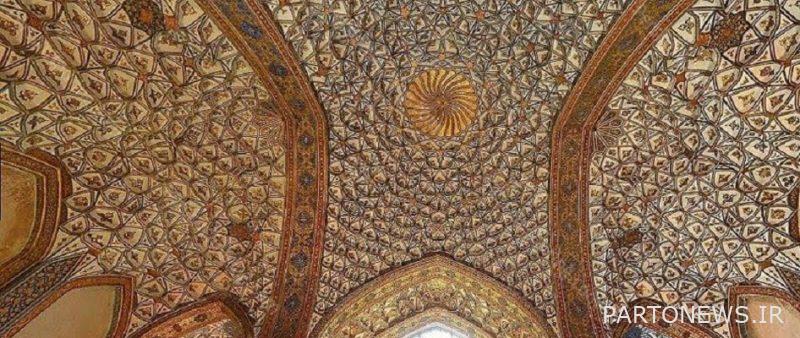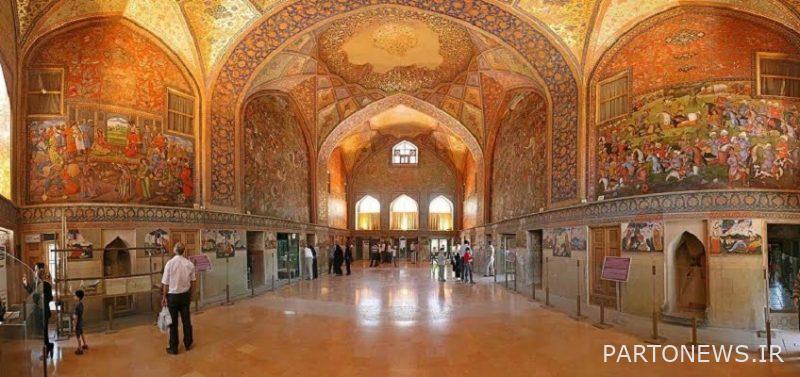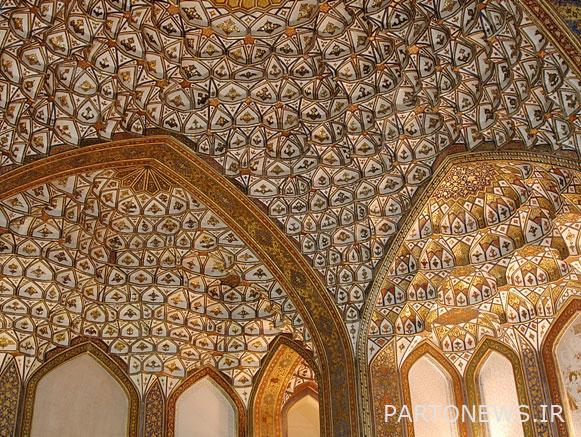Ashraf Halls of Isfahan – Siri in Iran

The mansion known as “Ashraf Hall” is located in the area of Safavid Government House and next to buildings such as Hashtbehesht Palace, Rakibkhane Palace, Timuri Hall, Chehlstun Palace and Ali Qapo Palace, and it is among the remaining palaces from the Safavid era.
Ashraf Hall is built using wooden beams and its flat roof is placed on high gold bases. This mansion has a large hall in the middle of the building surrounded by side rooms. The main hall has an arched ceiling, like the ceiling of the sky, which is decorated with moqranskari and train with gold covering and colored and azure plasters.
Decorations such as gilding, layering with plant motifs, plastering with geometric motifs and flowers and bushes, train and narrowing are used in this luxurious building and its entrance gate is also worked with knotted bricks in a prominent way. The multitude of moqrans, which are worked on the long and striking ceiling of this hall, is another feature of the main decorations of this mansion, so that among each moqrans, a traditional flower is gilded with layering technique and is eye-catching. At the highest point of the roof of the central hall, the revolving sun with 24 golden rays attracts the eye, and in the middle, a larger sun with 12 feathers is interesting.
According to Masoud Nikayin, a tourism expert, this luxurious and ornate building, which has a special effect and splendor in terms of its decorations, including paintings, beautiful moqrans, gilding, layering, plastering and proportional arches, according to Masoud Nikayin, a tourism expert, has nothing to do with Ashraf Afghan. The word “Ashraf” is because it is considered Ashraf of the halls of Isfahan. In fact, it should be known that “Ashraf Hall” was built during the time of Shah Abbas II and was completed during the era of his successor, Shah Suleiman.
Masoud Nikayin told ISNA about this mansion: Ashraf Hall mansion is one of the most magnificent and beautiful halls left from the Safavid period in Isfahan, with great plaster decorations and gilded moqrans, in the area of Daulatkhane and next to Rakibkhaneh mansion, Chehlsetun Palace, Ali Qapo Palace and Timuri Hall is located.
He stated that Ashraf Historical Hall is the best of the halls of the Safavid era, and added: The name of this unique building is “Ashraf” because of the uniqueness of its decorations and beautiful moqrans.

This tourism expert, pointing out that the center of Ashraf Hall is made of pure gold, which has 24 spokes and represents the hours of the day and night, said: Ashraf Hall shows the greatness and glory of the architectural art of the master craftsmen and super engineers of this art-loving country and it shows that the artists And the master craftsmen of this outstanding work were not a simple builder and they had mastered many sciences of their time and created this magnificent building with the support of rich Islamic and Shiite philosophy and thinking.
Nikayin continued: On the main wall of this hall, there is a painting of the Night of Ascension of the Prophet (pbuh) and at the bottom of it are verses from Ganjavi’s Masnavi Nizami describing the ascension of the Prophet (pbuh).
He said: The restoration of the plasters, paintings and arrays of this beautiful hall has been started since 2002 by the General Administration of Provincial Ceremonies and with the supervision and cooperation of the General Administration of Cultural Heritage, Handicrafts and Tourism of the province and many of its damaged parts with the presence of Isfahan artists and restorers within 20 It was renovated last year. Even now, it is decorated with some of the masterpieces of handicrafts and handicrafts of important artists of Isfahan and it is used as a museum hall and showcase of art and architecture of Isfahan, a place to visit, meet and meet with high-ranking foreign guests of the province. It is also under renovation.

During the Safavid era, this historical building was the residence of the king and the royal shrine, and during the Qajar era, it was used as the house of Sarm al-Doulah (commander of Isfahan’s military). Some researchers have written that at the beginning of the First World War between 1914 and 1918 AD, Ashraf Hall became a fodder warehouse and a residence for Russian soldiers and one of the military units was stationed there. In these years, all the decorations of the ceiling of this hall are hidden under plaster, which has somehow preserved these beautiful motifs.
At the end of the Qajar era, renovations were made in Ashraf Hall and it was saved from complete destruction. Ashraf Rozgari Hall also changed its use to Health and Civil Registry Department, Education Department, Culture and Art Department, Education Department, and since 2003, the General Department of Ceremonies and International Affairs of Isfahan Governorate has been located in this building.

In Chardon’s travelogue, Ashraf Hall is also mentioned and its restoration belongs to the end of King Suleiman’s reign. Another point is that in front of this building there is a rectangular pond with 4 wooded gardens on its four sides. In the northwest of the mansion, there is a large flat land that is the remnant of the Sadrieh mansion and is connected to Chehelston garden. Currently, a large exquisite hall and two small rooms on the sides of the main hall remain from that luxurious mansion.
This mansion, which was registered as one of Iran’s national monuments on January 15, 1310, is located on Bagh Goldaste Street, west of the Governor’s Street and is located in the vicinity of the Governor’s Garden, and is known as Ashraf Hall.

